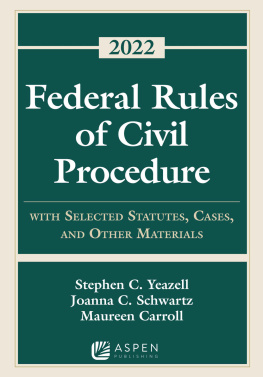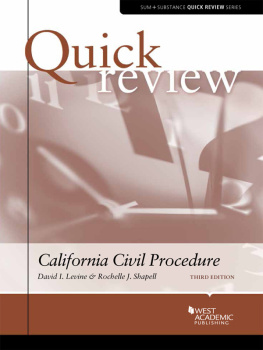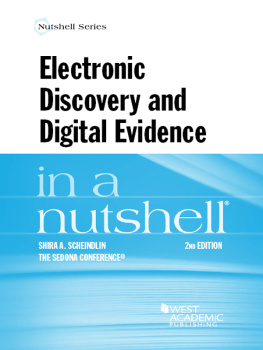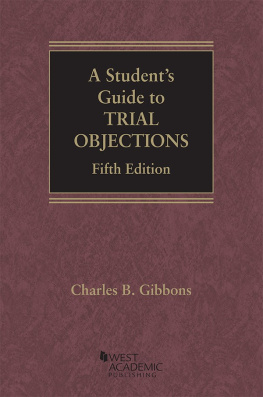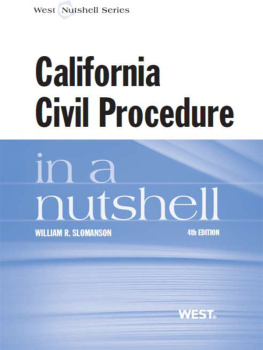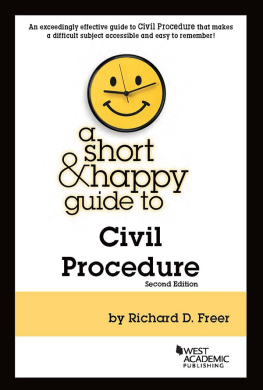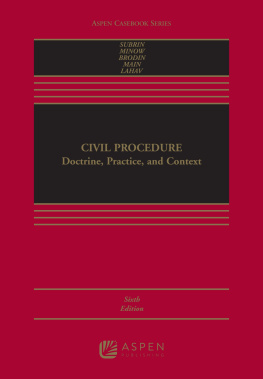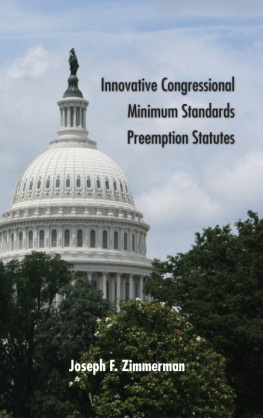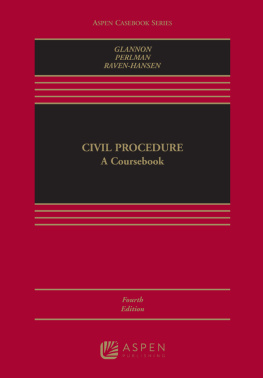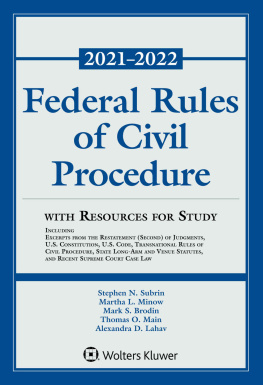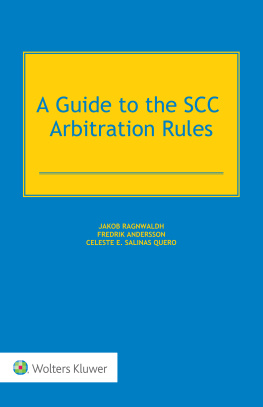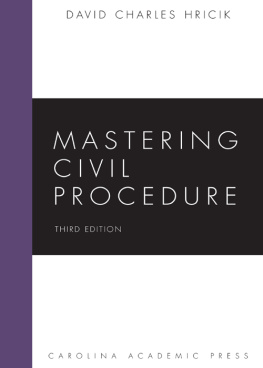i
FEDERAL RULES OF CIVIL PROCEDURE
With Selected Statutes, Cases, and Other Materials 2022
ii
EDITORIAL ADVISORS
Rachel E. Barkow
Vice Dean and Charles Seligson Professor of Law
Segal Family Professor of Regulatory Law and Policy
Faculty Director, Center on the Administration of Criminal Law
New York University School of Law
Erwin Chemerinsky
Dean and Jesse H. Choper Distinguished Professor of Law
University of California, Berkeley School of Law
Richard A. Epstein
Laurence A. Tisch Professor of Law
New York University School of Law
Peter and Kirsten Bedford Senior Fellow
The Hoover Institution
Senior Lecturer in Law
The University of Chicago
Ronald J. Gilson
Charles J. Meyers Professor of Law and Business
Stanford University
Marc and Eva Stern Professor of Law and Business
Columbia Law School
James E. Krier
Earl Warren DeLano Professor of Law Emeritus
The University of Michigan Law School
Tracey L. Meares
Walton Hale Hamilton Professor of Law
Director, The Justice Collaboratory
Yale Law School
Richard K. Neumann, Jr.
Alexander Bickel Professor of Law
Maurice A. Deane School of Law at Hofstra University
Robert H. Sitkoff
Austin Wakeman Scott Professor of Law
John L. Gray Professor of Law
Harvard Law School
David Alan Sklansky
Stanley Morrison Professor of Law
Faculty Co-Director, Stanford Criminal Justice Center
Stanford Law School
iii
FEDERAL RULES OF CIVIL PROCEDURE
With Selected Statutes, Cases, and Other Materials 2022
Stephen C. Yeazell
David G. Price and Dallas P. Price Distinguished Professor of
Law Emeritus
University of California
Los Angeles
Joanna C. Schwartz
Professor of Law
University of California
Los Angeles
Maureen Carroll
Professor of Law
University of Michigan

iv
Copyright 2022 Aspen Publishing. All Rights Reserved.
No part of this publication may be reproduced or transmitted in any form or by any means, electronic or mechanical, including photocopy, recording, or utilized by any information storage or retrieval system, without written permission from the publisher. For information about permissions or to request permissions online, visit us at www.AspenPublishing.com.
To contact Customer Service, e-mail , call 1-800-950-5259, or mail correspondence to:
Aspen Publishing
Attn: Order Department
PO Box 990
Frederick, MD 21705
Printed in the United States of America.
1 2 3 4 5 6 7 8 9 0
ISBN 978-1-5438-2051-5
ISSN 1074-4150
v
About Aspen Publishing
Aspen Publishing is a leading provider of educational content and digital learning solutions to law schools in the U.S. and around the world. Aspen provides best-in-class solutions for legal education through authoritative textbooks, written by renowned authors, and breakthrough products such as Connected eBooks, Connected Quizzing, and PracticePerfect.
The Aspen Casebook Series (famously known among law faculty and students as the red and black casebooks) encompasses hundreds of highly regarded textbooks in more than eighty disciplines, from large enrollment courses, such as Torts and Contracts to emerging electives such as Sustainability and the Law of Policing. Study aids such as the Examples & Explanations and the Emanuel Law Outlines series, both highly popular collections, help law students master complex subject matter.
Major products, programs, and initiatives include:
Connected eBooks are enhanced digital textbooks and study aids that come with a suite of online content and learning tools designed to maximize student success. Designed in collaboration with hundreds of faculty and students, the Connected eBook is a significant leap forward in the legal education learning tools available to students.
Connected Quizzing is an easy-to-use formative assessment tool that tests law students understanding and provides timely feedback to improve learning outcomes. Delivered through CasebookConnect.com, the learning platform already used by students to access their Aspen casebooks, Connected Quizzing is simple to implement and integrates seamlessly with law school course curricula.
PracticePerfect is a visually engaging, interactive study aid to explain commonly encountered legal doctrines through easy-to-understand animated videos, illustrative examples, and numerous practice questions. Developed by a team of experts, PracticePerfect is the ideal study companion for todays law students.
The Aspen Learning Library enables law schools to provide their students with access to the most popular study aids on the market across all of their courses. Available through an annual subscription, the online library consists of study aids in e-book, audio, and video formats with full text search, note-taking, and highlighting capabilities.
Aspens Digital Bookshelf is an institutional-level online education bookshelf, consolidating everything students and professors need to ensure success. This program ensures that every student has access to affordable course materials from day one.
Leading Edge is a community centered on thinking differently about legal education and putting those thoughts into actionable strategies. At the core of the program is the Leading Edge Conference, an annual gathering of legal education thought leaders looking to pool ideas and identify promising directions of exploration.
vii
CONTENTS
viii
ix
PREFACE
The federal procedural system flows from four major sources of law: (1) the Constitution of the United States, (2) the Federal Rules (of Civil Procedure and Appellate Procedure), (3) the Judiciary Code (collected in Title 28 of the United States Code), and (4) cases applying and interpreting these three bodies of law. This supplement contains examples of all four sources: the first three in . This volume is intended to serve as a rules supplement for any civil procedure course. The statutes and rules reflect amendments through December 1, 2021.
Stephen C. Yeazell
Joanna C. Schwartz
Maureen Carroll
November 2021
xi
NOTE ON THE FEDERAL RULES OF CIVIL PROCEDURE
The Federal Rules of Civil Procedure govern the conduct of civil trials in federal courts. Their authority comes from Congress, but, unlike the Judicial Code (Title 28 of the United States Code, found at page 199 of this supplement), the Rules are not a product of direct congressional legislation. Instead Congress has enacted 28 U.S.C. (the Rules Enabling Act), which authorizes the Supreme Court to promulgate rules of procedure.
Although the Rules Enabling Act gives the Supreme Court power to promulgate the Rules, the Justices do not in practice do the actual drafting. That process instead occurs in committees of the Judicial Conference, a supervisory and administrative arm of the federal courts. In 1988 a set of amendments to 28 U.S.C. formalized this committee process. Under these provisions the Judicial Conference appoints a standing committee on rules of practice, procedure, and evidence. This standing committee screens all recommendations for consistency. The Judicial Conference may also appoint committees with a more defined jurisdictionfor example, civil rules, rules of evidence, bankruptcy rules. Judges, practitioners, and scholars are appointed to these advisory committees. Each advisory committee considers proposals for amendments to the Rules, circulates drafts of proposed amendments to members of the bench and bar, holds public hearings and revises in light of the comments received, and then transmits the revised proposals to the Committee on Practice and Procedure, which reports to the Judicial Conference, which in turn recommends changes to the Supreme Court. In recent years the process surrounding Rules amendments has become more transparentopen to public and professional commentand simultaneously slower and more contested.
Next page
